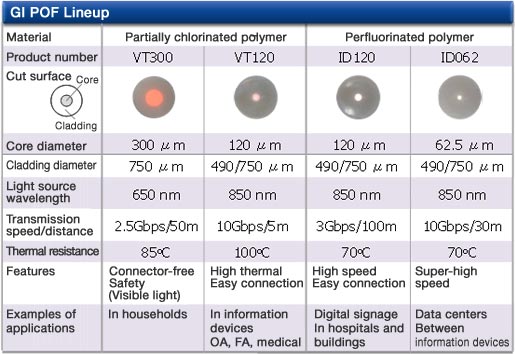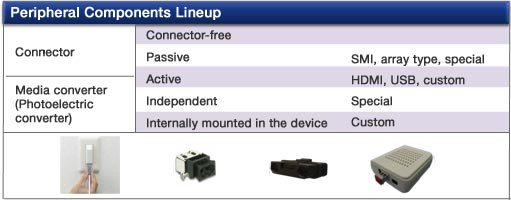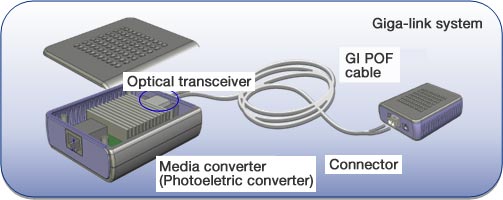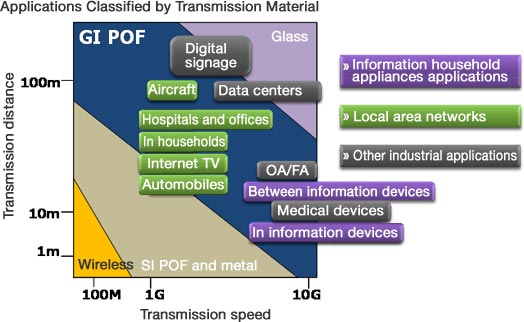In Preparation for a True "Face-to-Face Communication" Pioneered by "Giga-link Systems"
The Urban Infrastructure & Environmental Products Company (President: Yoshiyuki Takitani) of SEKISUI CHEMICAL CO., LTD. (President: Naofumi Negishi, hereinafter referred to as "SEKISUI CHEMICAL") is pleased to announce joint development with Professor Yasuhiro Koike of the Faculty of Science and Technology, Keio University, of "GINOVER," a graded index (*1) type plastic optical fiber (Hereinafter referred to as "GI POF (*2)) suitable for ultra-high-speed transmission in excess of gigabit size over short to medium ranges (1 – 100 m).
A product lineup will be made available that will be suitable not only for the high-speed transmission needs of home appliances such as hi-vision televisions and high-performance PCs, but also for a wide range of applications including medical, educational and welfare facilities, fields such as office equipment, automobiles, railways, aircraft and IT and medical devices internal transmission.
A product lineup will be made available that will be suitable not only for the high-speed transmission needs of home appliances such as hi-vision televisions and high-performance PCs, but also for a wide range of applications including medical, educational and welfare facilities, fields such as office equipment, automobiles, railways, aircraft and IT and medical devices internal transmission.
| *1: | Graded index (GI): The refractive index is adjusted so that the light propagated linearly at the core and the most frequently reflected light in the optical fiber arrive at the same time, resulting in realization of outstanding transmission speed and distance performance. |
| *2: | POF: Plastic Optical Fiber |
Background to Development
The increasing capacity of communication data for applications such as hi-vision images and distribution of movies over the Internet has given rise to a growing need for high-speed transmission in excess of gigabit size over short to medium distances both in devices and buildings. In addition to optical fiber, approaches currently such as wireless or metal cable are in wide use as means of high-speed transmission.
As well as reduced transmission distances at high speed, means such as wireless or metal cable present problems such as emission of and susceptibility to electromagnetic noise and increased power consumption. In addition, metal cable also features demerits including large cable diameter, the need for increased wiring space and weight. In light of all this, it is predicted that such means will be replaced by optical fiber in the future.
Because of its vulnerability to breakage due to its weakness to curvature and problems in terms of construction and connectivity due to factors including its small core diameter, quartz (glass) optical fiber currently in wide use has not been generally introduced for use over short to medium distances.
The increasing capacity of communication data for applications such as hi-vision images and distribution of movies over the Internet has given rise to a growing need for high-speed transmission in excess of gigabit size over short to medium distances both in devices and buildings. In addition to optical fiber, approaches currently such as wireless or metal cable are in wide use as means of high-speed transmission.
As well as reduced transmission distances at high speed, means such as wireless or metal cable present problems such as emission of and susceptibility to electromagnetic noise and increased power consumption. In addition, metal cable also features demerits including large cable diameter, the need for increased wiring space and weight. In light of all this, it is predicted that such means will be replaced by optical fiber in the future.
Because of its vulnerability to breakage due to its weakness to curvature and problems in terms of construction and connectivity due to factors including its small core diameter, quartz (glass) optical fiber currently in wide use has not been generally introduced for use over short to medium distances.
Features of Newly-developed GI POF, "GINOVER"

|
| 1. | Development of "Partially Chlorinated Polymer," a New Highly Thermal-resistant Material Capable of Handling Large Diameters and Visible Light GI-POF made of the newly-developed "partially chlorinated polymer" features a molecular design that reduces transmission loss in the red light source (650 nm) and can be directly connected to devices without using connectors due to its large-diameter formation capability. Additionally, the visible light source makes visual checking of the communication status possible, eliminating concerns over continually looking directly into the light. This is the world's first gigabit optical transmission system to be developed that the ordinary consumer can wire and connect. |
||
   |
|||
| Red light source (650 nm) |
|||
|
|
|
||
| 2. | Lineup of Grades (Core Diameter: 62.5 – 300 µm) matched to Usage Needs As well as large diameter and visible light grades, we have also developed grades to meet the requirements of high thermal resistance, long distance and ultra-high speed. A 62.5 – 300 µm (microns) core diameter lineup is available. "VT300" with a core diameter of 300 µm features large diameter and visible light, making this grade suitable for household use. "VT120" with a core diameter of 120 µm features high thermal resistance, making this grade suitable for the interior of information devices such as hi-vision televisions prone to temperature increases as well as OA, FA, medical and other devices. "ID120" with a core diameter of 120 µm is suitable for applications requiring high speed and on-site connector processing such as electronic billboards (digital signage) and the interiors of hospitals and buildings. "ID062" with a core diameter of 62.5 µm is suitable for applications requiring 10Gbps (Gigabits Per Second) transmission such as image transmission (HDMI (*3)) between facilities including data centers and information devices. |
||
|
|||
 |
|||
| 3. | Development of Various Gigabit Link Systems such as Connector-free Connectivity Systems and HDMI Depending on the application, requirements exist not only for transmission speed, but also for composite cable to meet flame retardation, economical wiring and power supply needs. Optimum cable shapes can be provided that take into account combination with elements such as connectors and optical transceivers (*4). In addition, full advantage can be taken of the features of GI POF through the total-link system design combining GI POF with connectors and optical transceivers by using the most appropriate method. Expansion of GI POF not only to daily-life scenarios, but also data transmission in and between state-of-the-art hospitals is anticipated. Total-link system design will facilitate replacement of existing technologies such as wireless and metal cable. In addition, realization of lowered costs is foreseen by standardizing various materials. |
||
|
|||
|
|
|
||
| Lineup of Cables and Peripherals Components | |||
  |
|||
| Image of Giga-link System | |||
 |
Concerning Future Development
SEKISUI CHEMICAL believes that giga-link systems with GI POF as their core will become the standard for true "Face-to-Face Communication." The benefits offered by GI POF will prove to be of extreme importance in the evolution of the field of communications.
The scale of the market for optical fiber for ultra-high speed transmission over short to medium distances is expected to exceed 150 billion yen in 2014. SEKISUI CHEMICAL aims to commercialize GI POF in FY2011 and to achieve sales of 15 billion yen in FY2015. Following this, the goal will be to continue active development of markets through GI POF and giga-link systems and achieve the world's top position in the field.
SEKISUI CHEMICAL believes that giga-link systems with GI POF as their core will become the standard for true "Face-to-Face Communication." The benefits offered by GI POF will prove to be of extreme importance in the evolution of the field of communications.
The scale of the market for optical fiber for ultra-high speed transmission over short to medium distances is expected to exceed 150 billion yen in 2014. SEKISUI CHEMICAL aims to commercialize GI POF in FY2011 and to achieve sales of 15 billion yen in FY2015. Following this, the goal will be to continue active development of markets through GI POF and giga-link systems and achieve the world's top position in the field.

[Reference] Concerning Joint Development with Professor Yasuhiro Koike of Keio University
Professor Koike has been involved in the joint development of GI POF since 2007. At the present time, Professor Koike's research has become joint research eligible for subsidy with practical application included in its scope under the Cabinet Office's "Funding Program for World-Leading Innovative R&D on Science and Technology" and GI POF is the results of this research.

Professor Koike has been involved in the joint development of GI POF since 2007. At the present time, Professor Koike's research has become joint research eligible for subsidy with practical application included in its scope under the Cabinet Office's "Funding Program for World-Leading Innovative R&D on Science and Technology" and GI POF is the results of this research.
Disclaimer
This press release may contain forward-looking statements. Such forward-looking statements are based on current expectations and beliefs and are subject to a number of factors and uncertainties that could cause actual results to differ materially from those expressed or implied by such statements due to changes in global economic, business, competitive market and regulatory factors.
This press release may contain forward-looking statements. Such forward-looking statements are based on current expectations and beliefs and are subject to a number of factors and uncertainties that could cause actual results to differ materially from those expressed or implied by such statements due to changes in global economic, business, competitive market and regulatory factors.
